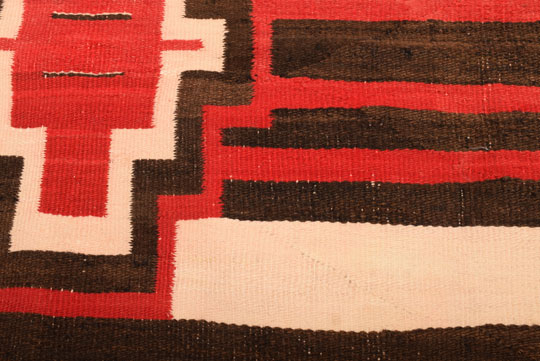Navajo Nation Third Phase Chief Blanket [SOLD]
+ Add to my watchlist Forward to Friend
- Category: Navajo Textiles
- Origin: Diné of the Navajo Nation
- Medium: wool, dye
- Size: 5 feet x 4 feet 10 inches
- Item # C4615C SOLD
This Navajo textile is classified as a Third Phase Chief Blanket. It is approximately 5 feet square. This textile features the pattern of a Third Phase Chief blanket but was woven in a larger size for use as a floor rug. The brown and white bands are traditional from the first version of the Chief blanket. The narrow red bands were added for a second version of the style. Lastly, the nine red stepped diamonds are from the style of the Third Phase blanket. This rug dates to the late 1800s.
The First Phase blanket was the earliest style and consisted of brown or indigo bands alternating with white bands. This style was like the striped shoulder blankets that the Diné had been weaving for a hundred years. The Chief blankets were woven wider than long, the only textile woven in this manner. The First Phase blankets were of a finer weave than other wearing blankets because of their popularity with the Plains Indians. The finer weave would gain the Diné more in trade value.
The Second Phase blankets incorporated small amounts of red yarn in the design. The source of the red yarn was commercial cloth which the weaver raveled and reused. Since the commercial yarn was a tighter spin, the weaver then spun her native yarn tighter so there was no visible discrepancy in the finished textile. This resulted in a superior finished product.
It was during the mid-1860s that the Third Phase blanket was created. The use of red yarn in Third Phase blankets increased from that used in the Second Phase blanket. Large sections were devoted to red designs as if superimposed over the First Phase bands of white and brown.
The Diné had been captured by Kit Carson for the government to relocate them to an encampment in southern New Mexico known as Bosque Redondo. After four years of incarceration, they were released and allowed to return to their previous homelands, but now a government reservation.
Once relocated to a reservation, the Navajo were forced by convenience to trade with the government Indian traders being established nearby. These reservation traders were more sympathetic to the needs of the Navajo than prior government personnel. It was the traders who convinced the women to convert their blanket weaving to floor rugs for which the traders would find a market in non-Indian homes.
The Third Phase pattern was a survivor of this conversion. The change from blanket to rug was basically in its size. Weavers were encouraged to increase the size of their looms and weave larger textiles suitable for use on the floor. Early Indian traders on the Navajo Reservation deserve credit for the existence of Navajo rugs for today's market.
Condition: very good condition after being professionally washed and repaired.
Provenance: this Navajo Nation Third Phase Chief Blanket is from the estate of a former resident of New Mexico
Reference: The Navajo Weaving Tradition 1650 to the Present by Alice Kaufman and Christopher Selser, E. P. Dutton, Inc. New York, 1985.
TAGS: textiles, Navajo Nation

- Category: Navajo Textiles
- Origin: Diné of the Navajo Nation
- Medium: wool, dye
- Size: 5 feet x 4 feet 10 inches
- Item # C4615C SOLD



